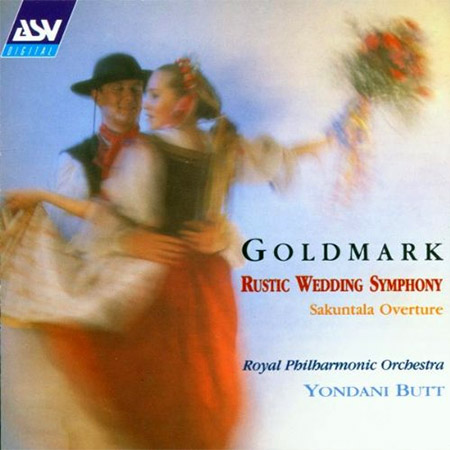Post by Slinger on Jan 1, 2017 0:15:11 GMT
January 2017 : Karl Goldmark - Rustic Wedding Symphony
Royal Philharmonic Orchestra / Yondani Butt.

Happy New Year everyone (well, the 4 or 5 people who are likely to read this anyway) and what better way to start a new year than with a wedding? Yes I can think of loads too, but...
The Rustic Wedding Symphony, Op. 26 (Ländliche Hochzeit) is a symphony in E flat major by Karl Goldmark, written in 1875, a year before his renowned Violin Concerto No. 1. (Well worth investigating if you don't know the piece.) The symphony was premiered in Vienna on 5 March 1876, conducted by Hans Richter. Johannes Brahms, who was a frequent walking companion of Goldmark's, and whose own Symphony No. 1 was not premiered until November 1876, told him "That is the best thing you have done; clear-cut and faultless, it sprang into being a finished thing, like Minerva from the head of Jupiter". Its first American performance was at a New York Philharmonic Society concert, conducted by Theodore Thomas on 13 January 1877.
The work does not conform to the standard structure of a symphony, and it could just be named a Suite. It is in five movements rather than the usual four, which is same as Beethoven's Pastoral Symphony, Berlioz's Symphonie fantastique and Schumann's Rhenish Symphony. It is full of Central European charm, joviality and good humour. While Goldmark did not provide any specific program for the work, he did give each of the movements titles suggestive of aspects of a wedding in the countryside.
It opens with Wedding March Variations (Moderato molto), the simple theme, with familiar musical connotations, announced at the outset by the lower strings, to be taken up by the wind in the first variation. The strings provide a more lyrical second variation, leading to a cheerful outburst of sound from the brass and to a more melancholy version of the material, replaced by a livelier contrapuntal treatment of the theme by the whole orchestra and a still more rapid scherzando variation. This is followed by a dramatic minor key version of the melody, followed by a variation with a running string counterpoint, relaxing into gentler lyricism in the variation that follows.
The ingenious treatments of the simple material continue with a running variation for the violins, succeeded by a more ponderous return to the minor and a version in which the woodwind has a significant part to play, with a solo violin. A brief fanfare heralds the return of the original Wedding March and the theme is entrusted yet again to the lower strings.
The second movement is a Bridal Song (Brautlied - Allegretto). The third movement, Serenade (Allegro moderato scherzando), opens with a theme played by two oboes, later developed by the strings. It includes an imitation of bagpipes, played on oboe, clarinet, bassoon and cellos.
The fourth movement, In the Garden (Im Garten - Andante), is slow and lyrical, its middle section moving to E-flat minor. The finale, Dance (Allegro molto), is the only movement of the work written in sonata form. It opens with a fugue. The Garden theme briefly reappears, before the Dance returns to end the movement rousingly.
Symphony? Suite? Symphonic Poem? Something not beginning with "S"? Do I really care? The correct answers are possibly Yes, Yes, Yes, Maybe, and No.
The Rustic Wedding Symphony was a favourite of conductors such as Thomas Beecham and Leonard Bernstein. It has been recorded a number of times, by conductors such as Beecham, Bernstein, André Previn, Maurice Abravanel, Jesús López-Cobos, Yondani Butt and Stephen Gunzenhauser. To be completely honest, I slightly favour the Beecham recording I have of this piece, but couldn't find the whole thing on YouTube so I went with the Yonandi instead. I have however placed a Spotify link for the Beecham at the bottom if you get that far.
Beecham takes most of the movements at a much faster clip which I think is more in keeping with the subject matter whereas Yonandi's take is much more slow and stately. Of the other versions I own, Bernstein takes it even slower than Yonandi in most places, but not all, and Herman Abendroth completely mixes it up with (in relation to Beecham) the first movement being a fraction slower but the whole piece clocking in at 2:22 faster.
Here as a "for instance" are my timings for the 4th movement, described as slow and lyrical, which is where there is probably the greatest variance...
Yonandi - 11:32
Bernstein - 10:17
Beecham - 8:32
Abendroth - 7:42
If nothing else it's a great piece for observing how different conductors see the same set of tadpoles on telegraph wires but hear them differently.
WOW! It isn't Mahler and it doesn't have the Cello in a starring role!
Anyway...on with the wedding, which I hope you enjoy as much as I do. Try not to take to much advantage of the free bar, or the bridesmaids.


